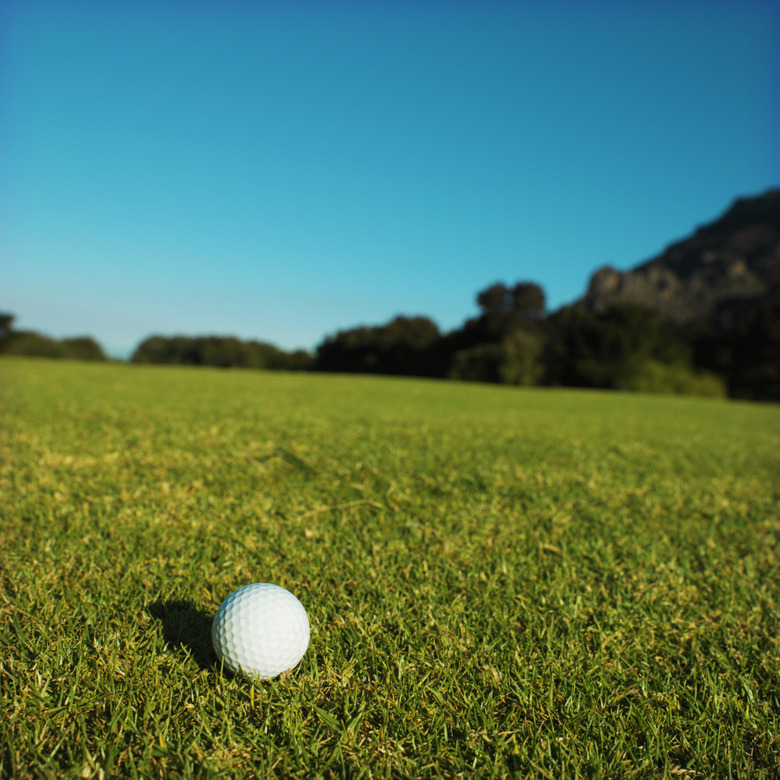Dark Green Grass Types
Lush, dark, green grass gives not only a pleasing appearance to urban and home landscaping, but makes a wonderful carpet for recreational activities and an ideal ground cover for parks and golf courses. Grass helps control erosion and dust, as well as helping maintain steady temperature levels. Regardless of how much use the grass area gets, the type of lawn activity, whether there is little or full sun and the climate for your region, there is a grass type for your needs. Dark green grasses frequently require regular watering and fertilizer applications to keep their rich color.
Zoysia Japonica
Step 1
Zoysia japonica, a member of the Zoysia species, and generally referred to as Zoysiagrass, has a deep, dark green color and and produces a thick turf that is very tolerant of a number of conditions, but not cool weather. Originally from Southeast Asia, all Zoysia species can withstand low irrigation levels, high temperatures and salt conditions. Zoysia japonica however, is the most cool-weather tolerant of the three speicies and thrives in U.S. Department of Agriculture plant hardiness zones 6 through 11. With its deep root system, Zoysia japonica can tolerate moderate levels of wear and tear and will turn brown during the cool winter months when it is dormant.
- Lush, dark, green grass gives not only a pleasing appearance to urban and home landscaping, but makes a wonderful carpet for recreational activities and an ideal ground cover for parks and golf courses.
- Zoysia japonica, a member of the Zoysia species, and generally referred to as Zoysiagrass, has a deep, dark green color and and produces a thick turf that is very tolerant of a number of conditions, but not cool weather.
Perennial Ryegrass
Step 1
Perennial ryegrass (Lolium perenne) produces a green lawn year-round. Best suited for moderate and mild temperatures, perennial ryegrass nonetheless grows in USDA hardiness zones 3a through 12b. Preferring direct sunlight, perennial ryegrass is highly tolerant of regular foot traffic and can be mixed with other varieties that are dormant during the winter time to produce a lush, dark green lawn year-round. Perennial ryegrass is cold-weather tolerant.
Bluegrass
Step 1
Kentucky bluegrass (Poa pratensis) is a cool-weather grass variety that is able to repair itself because of its rhizome-based construction. With its thick, dense turf and ability to tolerate moderate use levels, Kentucky bluegrass is often mixed with perennial ryegrass to produce a year-round green lawn. While it grows well in USDA hardiness zones 3 through 8, Kentucky bluegrass does best when the average temperatures are less than 75 degrees Fahrenheit each day, as it does not do well with extreme summer temperatures or low irrigation levels.
- Perennial ryegrass (Lolium perenne) produces a green lawn year-round.
- Preferring direct sunlight, perennial ryegrass is highly tolerant of regular foot traffic and can be mixed with other varieties that are dormant during the winter time to produce a lush, dark green lawn year-round.
Fescue
Step 1
Hard fescue (Festuca longifolia) is a cool-weather grass that unlike other grasses, enjoys growing in shady conditions. Because of this, it works well as a ground cover for slopes or hillsides. Not as tolerant as the other varieties, hard fesuce prefers little foot traffic. It can reach up to 12 inches in height and does not require high levels of fertilizer It does best in USDA hardiness zones 3 through 8. Interestingly, one of the dark green hard fescue varieties, "Scaldis" is well-suited as a no-mow grass, but it requires regular watering during the summer months.
References
- United States Department of Agriculture: Perennial Ryegrass
- University of California IPM Online: The UC Guide to Healthy Lawns
- University of California Davis: Managing Turfgrasses During Drought
- OnlinePlantGuide.com: Kentucky Bluegrass
- Texas A&M University: Zoysiagrass
- University of California: No-Mow Fineleaf Fescue Grasses for California Urban Landscapes
- New York State Department of Transportation: Plant Materials for Vegetation Management along New York State Roadsides
- University of Rhode Island: Selection of Turfgrasses
- United States Department of Agriculture PLANTS: Lolium Perenne L.
- United States Department of Agriculture Plant Hardiness Zone Map
